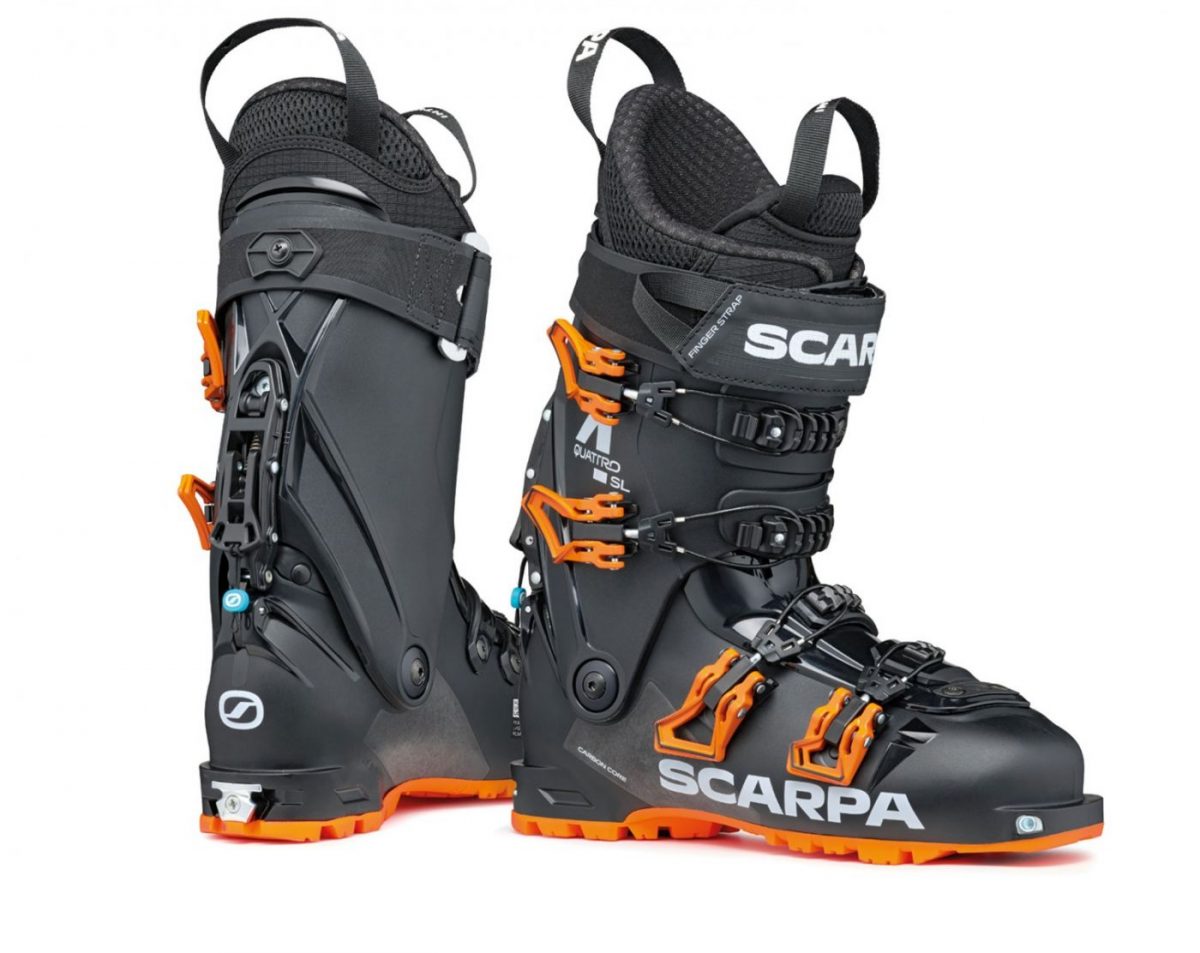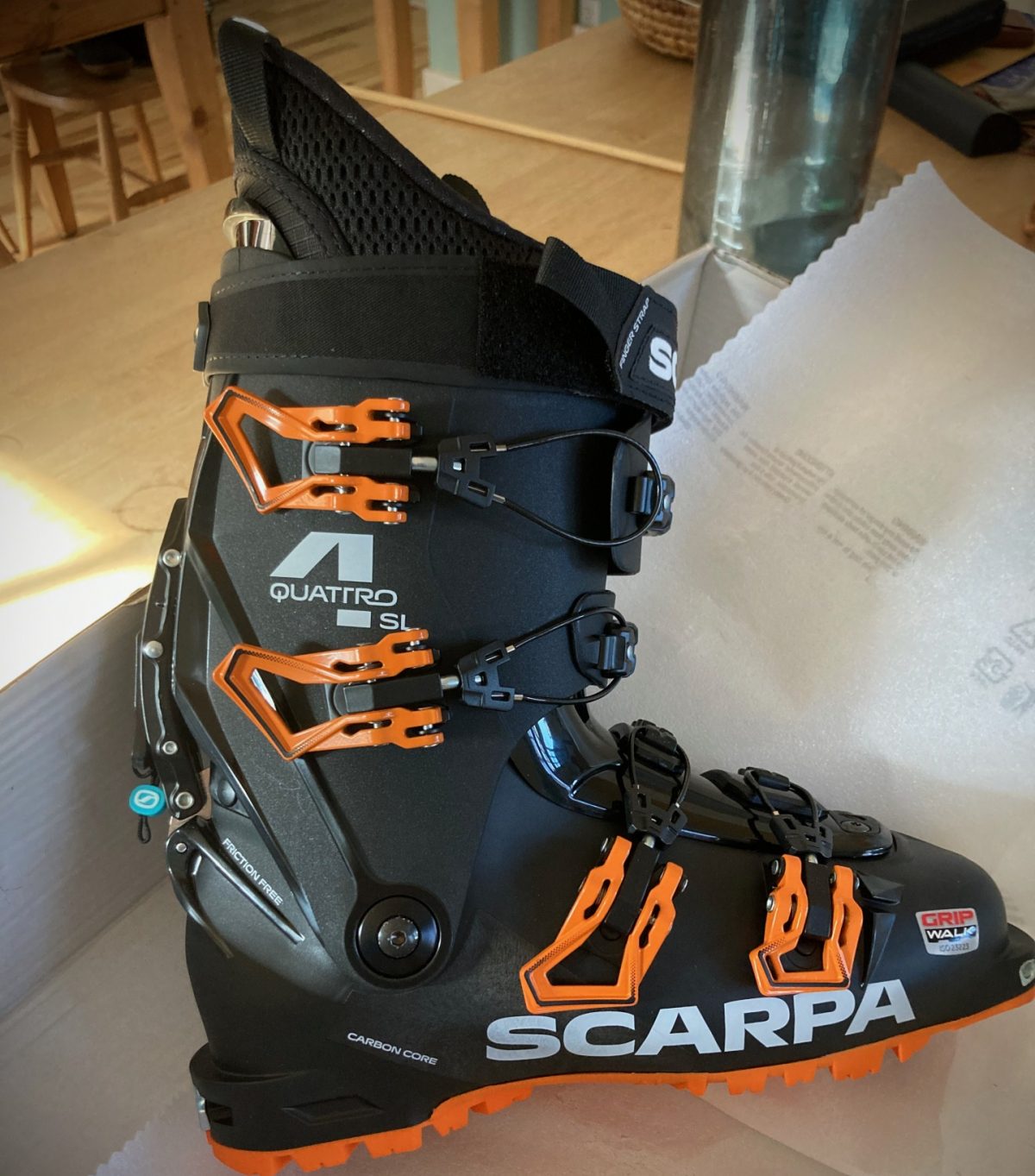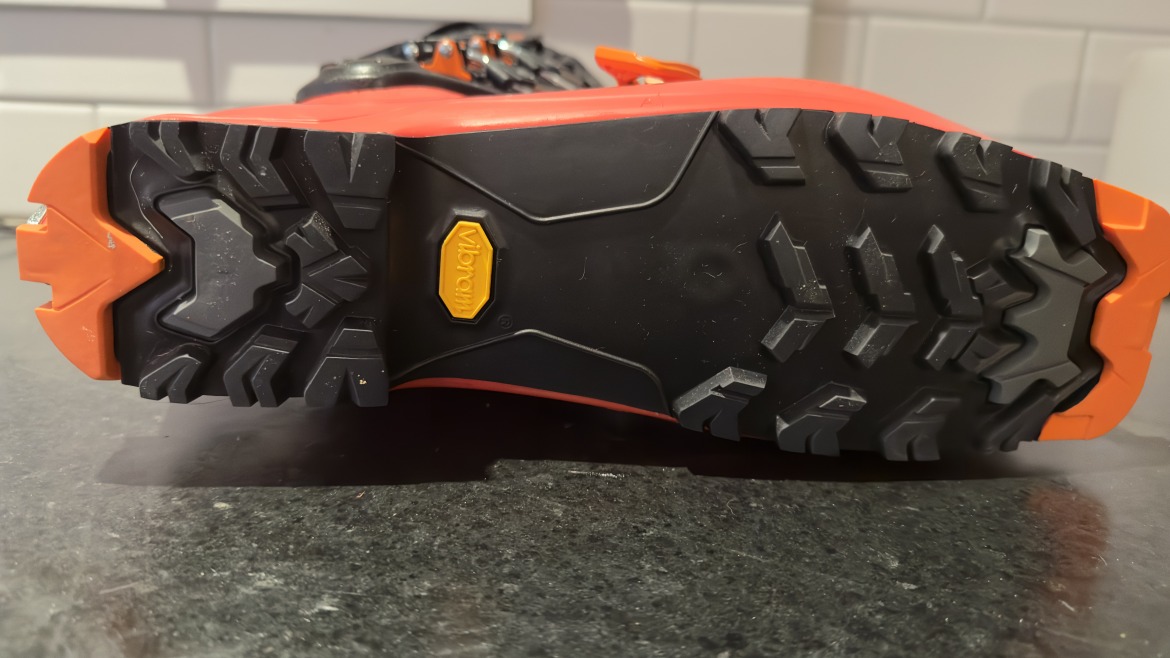Scarpa’s 4-Quattro boots feature a Grip Walk sole, making this an option for those riding lifts or questing in the backcountry. The off-piste reality may convince you this is your power touring boot. The Scarpa 4-Quattro SL can tour and most certainly ski.
Scarpa 4-Quattro SL Specs
Size tested: 27
Last (claimed): 100mm in the 27
Weight Verified: 1432g (a bit lighter than a 27.5 Fischer Transalp Pro) and a few paper clips lighter than a Scarpa Maestrale.
Shell/Cuff Material: Pebax R-New® Shell with an over-injected Carbon Grilamid® LFT insert
Sole: Presa Ski-01/GripWalk Tour
Liner: Intuition/heat moldable
ROM: 61-degrees
Flex rating (claimed): 120
Forward Lean: 17 +/-2
Model: The Quattro also comes in an XT model, rated 130 flex.
Price: The SL is $699, and the XTs cost $799.
We’ll spend a little time up top on the crossover attributes of the Scarpa 4-Quattro SL. This is a stiff boot. The four buckles and a rigid Carbon Grilamid shell are the telltale signs. And if you are riding lifts with the 4-Quattro SL and are dangling planks secured to your boot with a Grip Walk alpine binding (GripWalk is ISO 23223 certified), you’ll be good to go. These boots are also compatible with slightly lighter bindings like Salomon Shifts and Marker Kingpins.
For the time being, and foreseeable future, we’ll be skinning and descending with this relatively light 1432g 120 flex boot without a chairlift assist. And for our purposes, because we like lean when it can be lean, the 4-Quattro SLs are clicked into lighter tech bindings ranging from 180g to 300g.
Not every boot is for every skier. For every attribute of the 4-Quattro SL that makes this a perfect boot for one ski tourer, another claiming that the same feature is a deal breaker will come along. First, let’s tackle the most divisive aspect of the 4-Quattro SL: fit.
Fit
The boots have a low instep, a claimed 100mm last, a forefoot trending towards lower volume, and a slim but not too narrow ankle. Getting my foot into the boot is a non-issue when I loosen all four buckles and the power strap, open the shell up slightly and insert the foot (I wear a lightweight ski sock). I don an EZ-Fit ankle bootie with some boots I wear to prevent hot spots or suck up some volume. So far, in the 4-Quattro SL, I’m not finding the need. With the lowest buckle secured semi-loosely combined with the boot’s low instep, and solid heel hold, there’s no heel movement when skinning.
I’m usually 27.0 / 27.5 in boots, and depending on the model, I use a 27 or 27.5 liner. This boot is a 26.5/27 shell with a 27 liner. I can not go smaller; my toes barely braise the front. It is a performance fit for me in length and width (from the instep through to the toes). I expect some potential 4-Quattro SL and XT users will go back and forth between shell sizes/liners before they zero in on what works.
As is the case with Scarpa, the boot comes stock with a high-quality heat moldable Intuition liner. The upper cuff and tongue are loaded with dense and relatively rigid foam to help support the stiff nature of the shell’s cuff and plastic tongue.
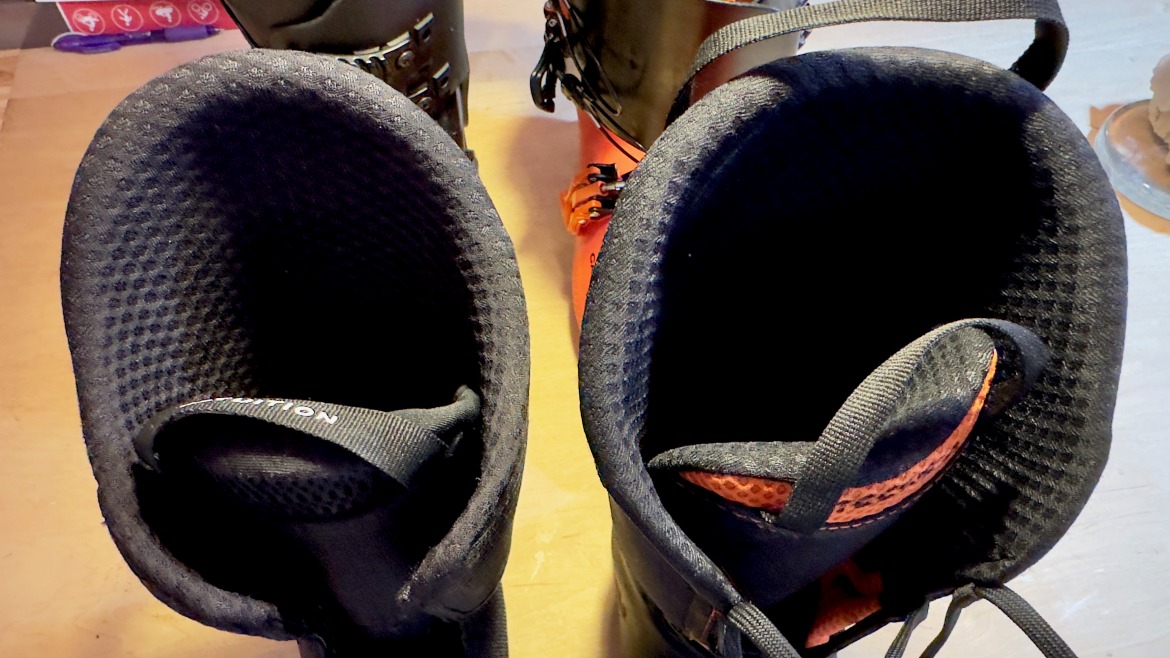
The 4-Quattro SL liner on the left with the Tecnica ZG Tour Pro liner on the right. The foam throughout the Scarpa liner’s cuff is noticeably more dense (to the touch) than the Tecnica liner. Yet, both boots do ski legitimately stiff with the Scarpa a claimed 120 flex and the ZG Tour Pro a 130 flex.
If you scroll through the comments over the years at WildSnow regarding boots and fit, you’ll see that sometimes the digital citizenry skews towards a “what have you done for me lately” attitude regarding boots. I once complained to a friend that the sleeve length in an outdoor company’s new apparel ran too long. And his reply was rhetorically spot on, “according to who? You mean your specific arm length?”
The 4-Quattro SL will not fit everyone. However, some portions of the fit are average, like calf volume (they fit my calf without reducing the volume around the cuff, and I’ve got skinny calves), and some dimensions, as noted, run on the low-volume side.
The last ounce to squeeze out on fit is that as I have the boot slotted into my rotation as a wintertime boot when I drive a longer and wider ski, which is all winter— the snug fit works. My foot swells on longer tours as temps warm, especially when pummeled by a stronger Sun. I’d likely need to size up if this were my spring boot.
Ok, one more drop to squeeze…the Tecnica Zero G Tour Pro gets a lot of love. And it should — great skiing, passable walking and climbing, and legit four-buckle power. From a fit perspective, the Quatro SL (or XT…that review comes later this season) and the ZG Tour Pros are markedly different. I can make both boots work with stock liners, but given an average foot, you likely will find yourself looking for slightly more space with the 4-Quattro SL and possibly reducing volume in the ZG Tour Pro. But, these boots are two different solutions to the same problem: how to build an effective uphilling boot that provides optimum performance on the descents.
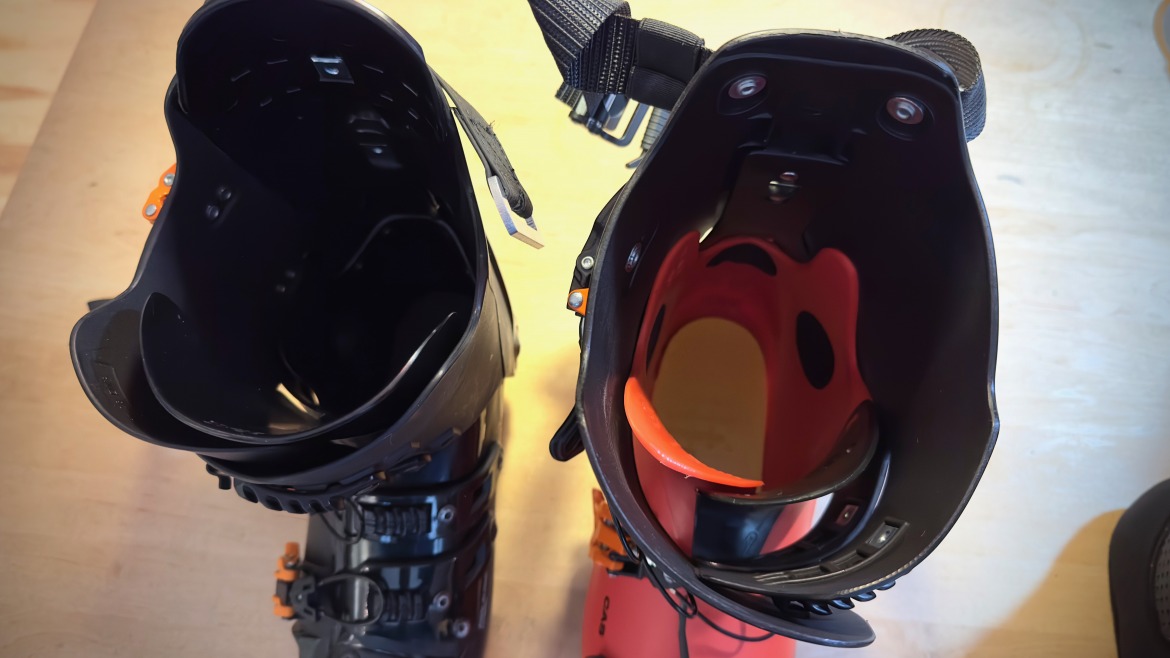
The 4-Quattro SL (left) posed next to the Tecnica Zero G Tour Pro. Looking down into the cuffs, the 4-Quattro SL gains some its stiffness via the alpine overlap cuff (like the ZG Tour), yet the Scarpa boots employs a long plastic tongue as part of the build.
Descending
This will be a short section. The 4-Quattro SL, at a rated 120 flex, is a legit 120 flex (and maybe more) with its alpine overlap design. Literally, buckle up, tighten the power strap, flip the ski/walk lever down, stomp the heel, and you should be ready to charge. I can imagine few pure backcountry skiers, or freeridey tourers, feeling underpowered with the 4-Quattro SL…and if you suspect you might be, go a flex rating higher with 4-Quattro XT.
I prefer a bit more forward lean in my boots. For example, with the ZG Tour Pro, the forward lean is 12-13 degrees. I’ve added a velcro spoiler to bump me forward a bit in the ZG. The 4-Quattro SL comes with a 17 (+/- 2) degree forward lean, which might seem aggressive to some. I like the 15-17 degree sweet spot.
If you are a 50/50 skier, with half your time in bounds, this boot can be a one-boot option. But, in spring, with skinnier and lighter skis, I’d say anything under 95mm, you’ll have a bunch of horsepower to drive the ski, but maybe too much.
The Ascent
Let’s assume you’ve left the chairlift far behind. The 4-Quattro SL is going to be well-liked on the ups. For what you get with the downhill performance, you’re not sacrificing much skinning in this boot. The range of motion is a claimed 61 degrees. Of those 61 degrees, you get slightly more of that range moving back than forward. And the friction one might expect with a beefier boot and a rigid-tongued liner, as we see with the 4-Quattro SL, feels relatively free. Although this is not a 1000g touring boot, the cuff rotation is surprisingly fluid. Like I noted in my first look, on steeper skin tracks, I’m reaching for a higher riser more frequently with the 4-Quattro SL due to its more limited range of motion compared to the speed touring boots I often use.
The reality of my anecdotal observations is that many of the folks I ski with (or see skiing) opt for more downhill-oriented boots in winter. In other words, there’s a premium placed on great downhill performance and a willingness to sacrifice a bit of touring prowess for that benefit. In the 4-Quattro SL, what you are giving up is not much — especially if you drive bigger skis. These are touring boots. In my view, they just so happen to be compatible with binding options you’d use at the resort. If you are a 100 percent human-powered skier, and the boots fit well, you’ll likely not be disappointed while skinning.
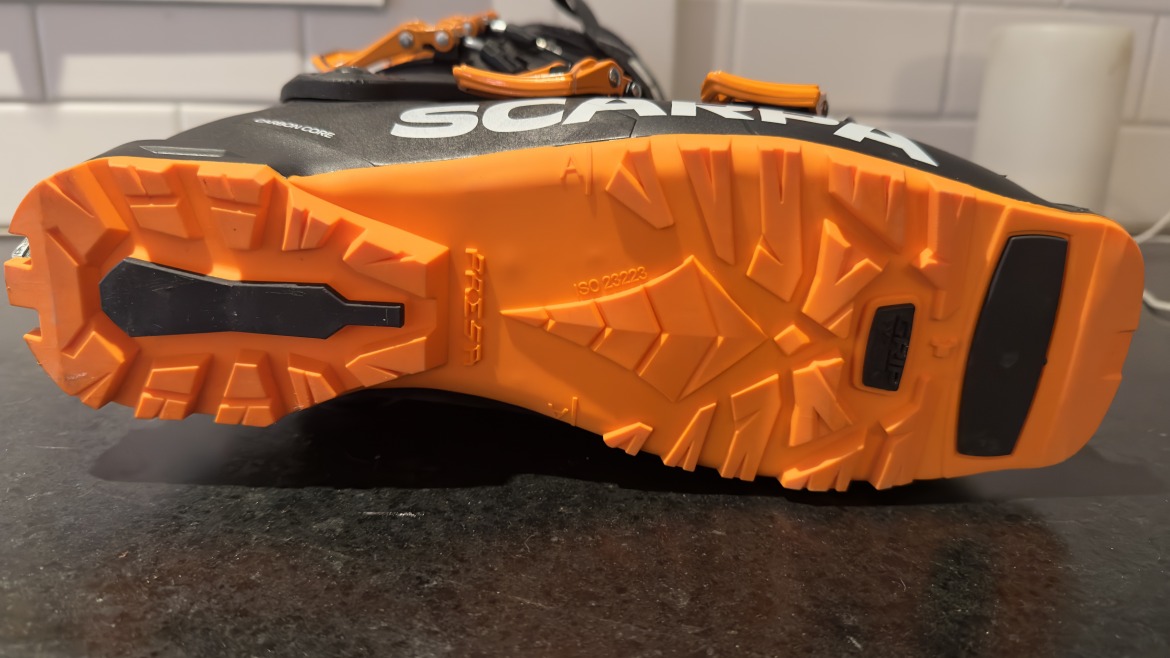
Bottom view of the 4-Quattro SL with the Grip Walk sole. Under the toe is a lugless and flat region.
However, walking in the Grip Walk sole has a different feel than walking in a boot with a more traditional tech boot sole. For example, the ZG Tour Pro rolls onto the forefoot when walking (it’s a slightly rockered sole), whereas the 4-Quattro SL seems to pivot onto the forefoot as if tipping a small fulcrum. This is likely due to the small platform under the Grip Walk toe, which is lugless.
The Grip Walk sole might not be a biggie if you use the 4-Quattro SL to boot up steep snow-filled chutes in winter and spring. In this case, I assume you are kick-stepping and weighting the boot’s toe in softish snow, which can support body weight. I’d want crampons on in steep and slippery situations where you must step on and pivot up on the toe. But, to be fair, in most slippery situations, I’m in crampons anyhow, Grip Walk sole or not.
Regarding scrambling in the 4-Quattro SL’s Grip Walk soles, I can see issues if you cannot habituate yourself to the slightly different sensation underfoot when walking. If this is your single go-to boot, that is something to consider. If this is still your go-to boot and you never scramble on rocks, then out of sight, out of mind.
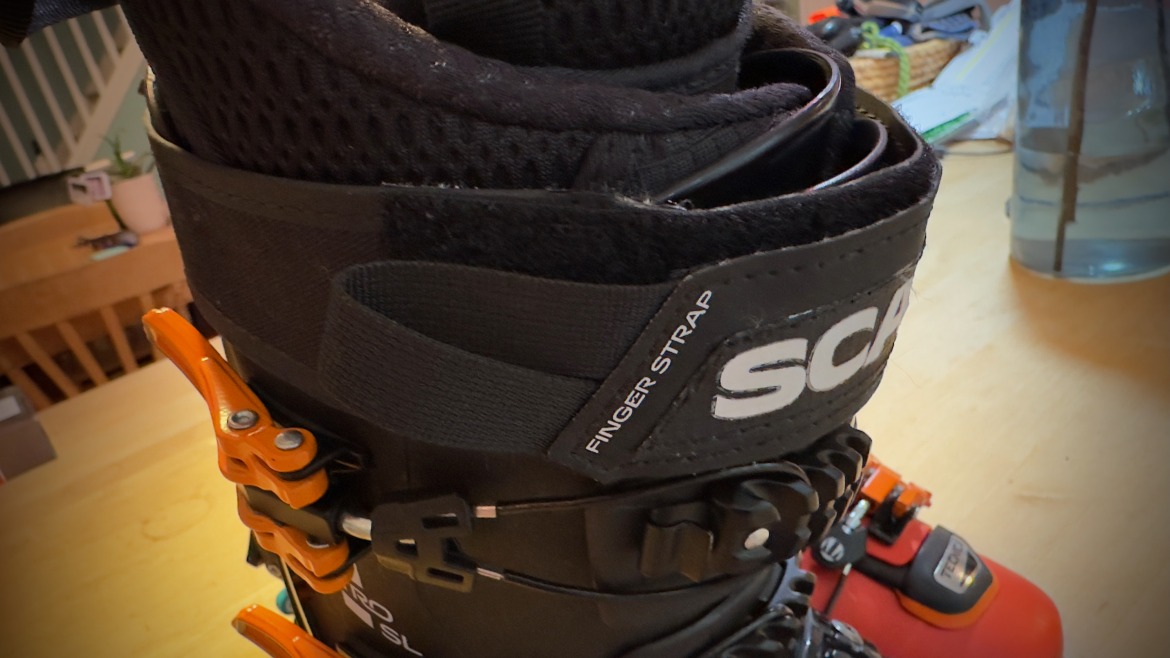
In many ways the Scarpa 4-Quattro SL comes in as a near complete package. I would like to see a ratcheted cam type power strap, it comes stock with a velcro power strap.

The new ratcheted cam style power strap on the Zero G Tour Pro is a power move when it comes to helping stiffen the upper and locking in place.
Transitions
Expect the usual with four buckles, a power strap to loosen, and a ski/walk lever to flip up. It won’t be ski-mo fast, but it’s not too time-consuming. The buckles are easy to use, as is the powerstrap.
I would make one change — I like a cam/ratchet system to secure/loosen powerstraps on beefier boots. The win here goes to the 2023 ZG Tour Pro power strap IMHO. The 4-Quattro SL’s velcro powerstrap system is fine but could be slightly improved with a cam tensioning system and a quick release on the cam unit, as seen on the Fischer Transalp Pro.
Closing Thoughts
If you had asked me five years ago if I would ever use a four-buckle boot in the backcountry, the answer would have been an unequivocal no. But times change. I may be older and slightly slower, but I, too, am marginally wiser. A four-buckle touring boot can offer superior control. Scarpa’s 4-Quattro SL is fierce on the downhills. The uphills, with the 1432g weight (stock liner and insole) and range of motion, are not a hindrance, despite the boot shining more on the down than on the up.
In choosing a stiff boot, like any boot, it will come down to fit. I do like that Scarpa is likely trying to appeal to the crossover market but developed boots in the 4-Quattro series that can be a stand-alone backcountry power boot.
Jason Albert comes to WildSnow from Bend, Oregon. After growing up on the East Coast, he migrated from Montana to Colorado and settled in Oregon. Simple pleasures are quiet and long days touring. His gray hair might stem from his first Grand Traverse in 2000 when rented leather boots and 210cm skis were not the speed weapons he had hoped for. Jason survived the transition from free-heel kool-aid drinker to faster and lighter (think AT), and safer, are better.

